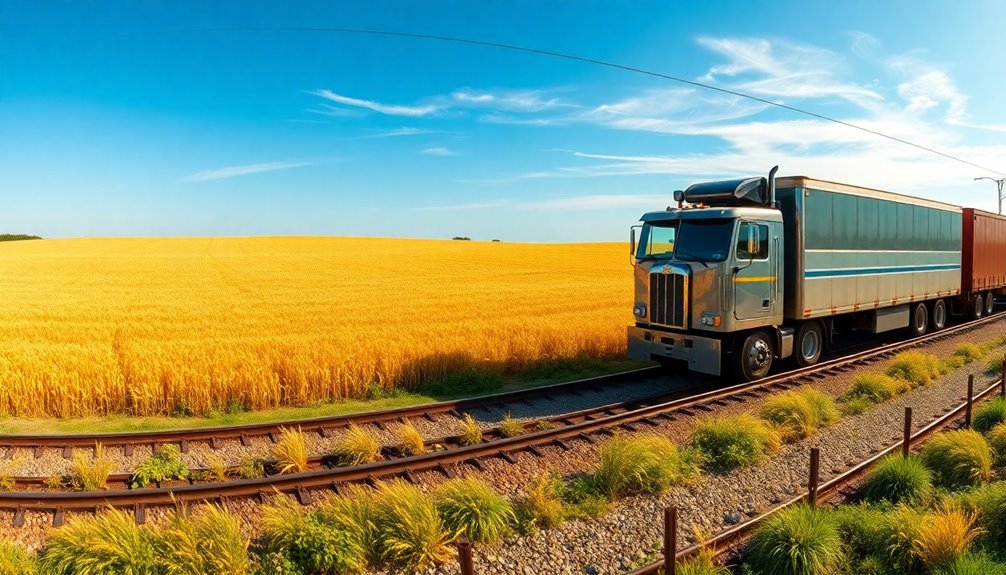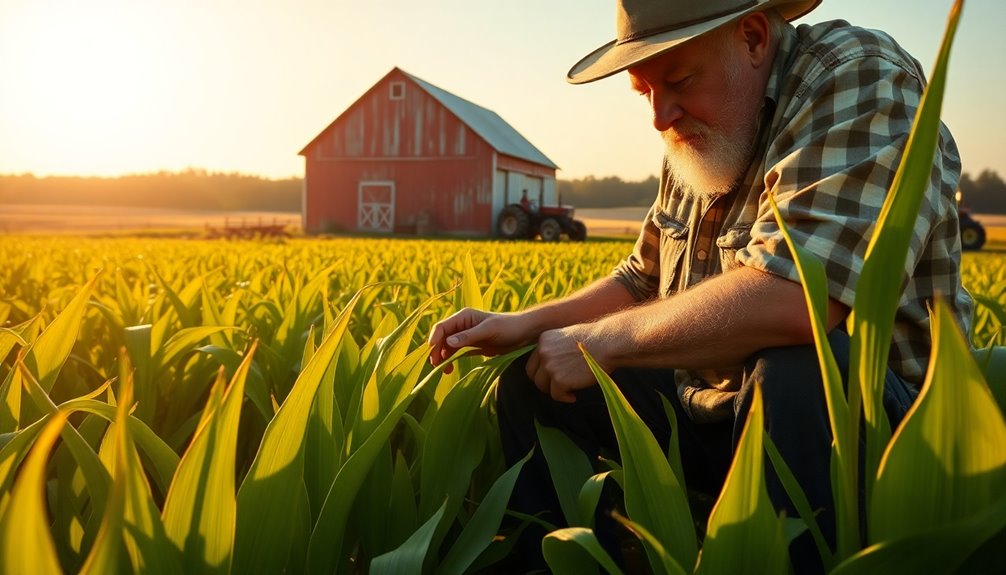Improved transportation changed farming dramatically by linking rural areas to larger markets. With railroads and steam-powered boats, you could move your crops quickly, reducing waste and increasing profit. Farmers began specializing in high-value crops, shifting from subsistence farming to commercial agriculture. This access drove production levels up over 400% between 1860 and 1900, boosting income and economic growth in rural communities. New technologies further enhanced efficiency, making it easier to meet consumer demands. If you're curious about how these changes impacted farming practices and the environment, there's a lot more to explore!
Key Takeaways
- Improved transportation, such as railroads, increased agricultural production by over 400% between 1860 and 1900 through better market access.
- Farmers transitioned from subsistence farming to specializing in high-value crops due to enhanced connectivity to urban markets.
- Mechanized farming tools and refrigerated transport revolutionized production efficiency, reducing labor needs and minimizing waste during distribution.
- Expansion of transportation networks lowered costs, making perishable goods more profitable and increasing agricultural surpluses that lowered food prices.
- However, these advancements also raised environmental concerns, including habitat loss, carbon emissions, and challenges to sustainability in agriculture.
Historical Context of Farming
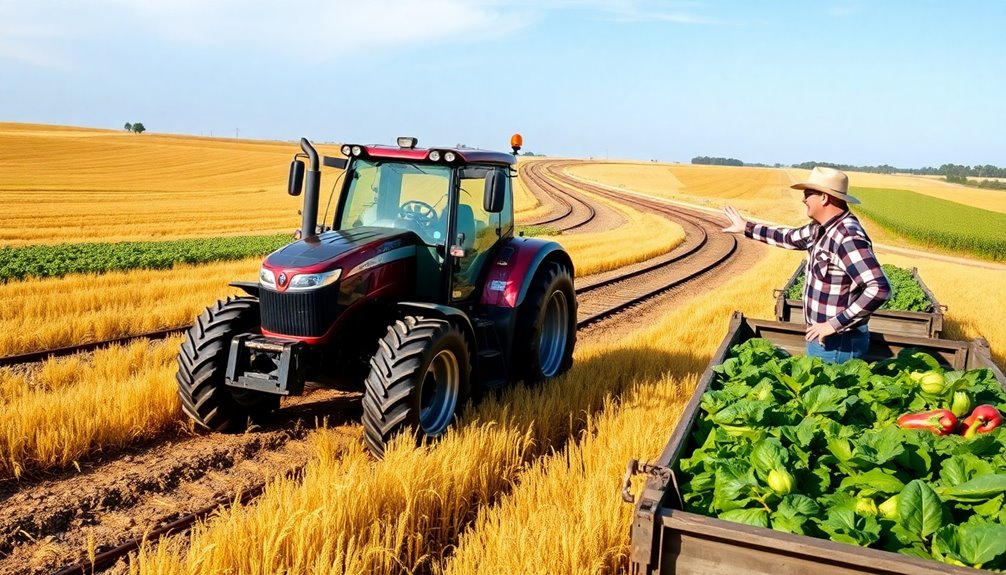
Farming has always been a cornerstone of human civilization, shaping societies and economies throughout history. You can trace the roots of agriculture back to around 8500 BC, when people first cultivated crops like wheat and barley in the Persian Gulf region.
The Agricultural Revolution marked a transformative shift in farming techniques, particularly with the advent of improved transportation networks. In the 19th century, railroads and steam-powered boats revolutionized the movement of agricultural goods, enhancing crop yields and expanding market access for farmers.
As these transportation infrastructures grew, rural areas gained better connectivity to urban markets, boosting trade opportunities. Historical efforts to optimize water and soil resources, combined with advancements in transport, greatly influenced agricultural productivity and community dynamics. Moreover, the increased efficiency in transporting goods echoed the benefits seen in modern systems like heat pumps, which also enhance energy management and productivity in various sectors.
Impact on Agricultural Practices
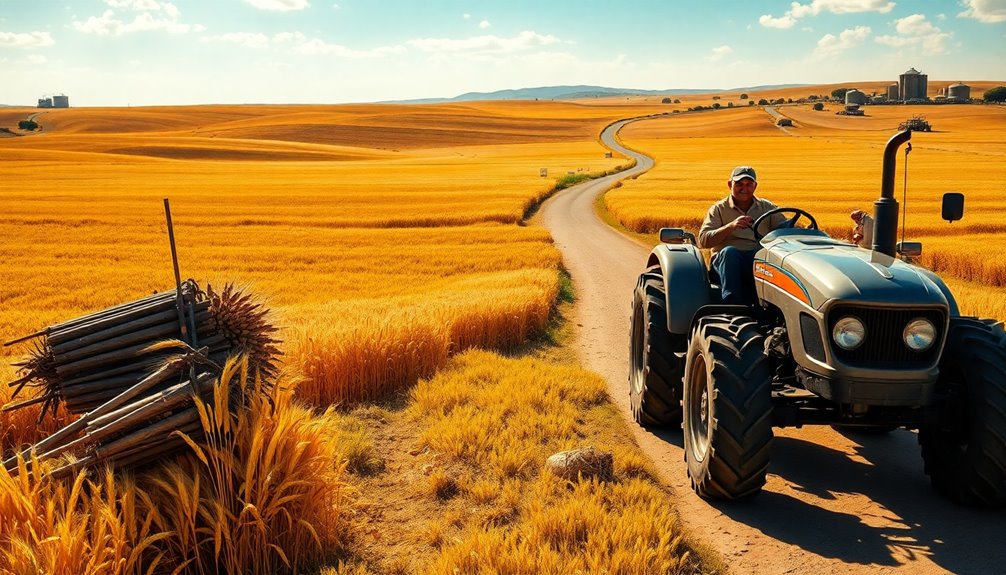
The advancements in transportation not only transformed how goods moved but also reshaped agricultural practices across the board.
With improved transportation, you saw a significant boost in production methods, allowing farmers to adapt to changing market demands.
Here are three key impacts:
- Increased Production: Farmers raised production levels over 400% from 1860 to 1900, thanks to easier access to distant markets.
- Specialization: Enhanced transportation enabled you to specialize in high-value crops, moving away from subsistence farming.
- Reduced Waste: Quick transport of perishable goods lowered waste, ensuring better quality and higher economic viability.
These changes not only improved the efficiency of agricultural operations but also transformed how goods and services were produced and delivered in the market.
Economic Growth and Market Access
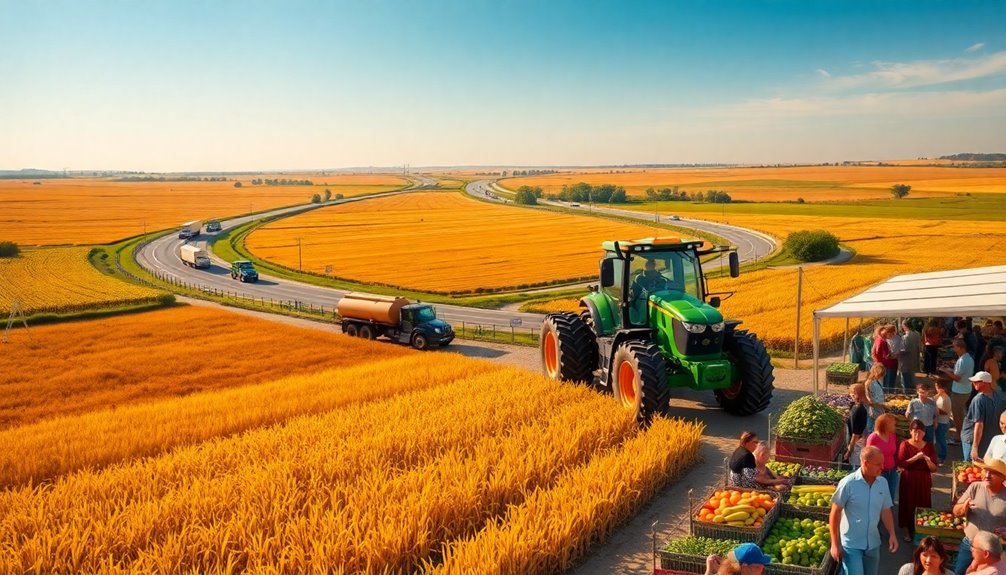
Advancements in transportation considerably opened up market access for farmers, driving economic growth in previously rural areas.
With improved transportation networks in the 19th century, you could access larger markets, which led to a remarkable increase in agricultural output—over 400% in the U.S. between 1860 and 1900.
The expansion of railroads and roads reduced transportation costs, allowing you to sell perishable goods more profitably while boosting food availability in urban centers.
This enhanced market access facilitated a shift from subsistence farming to commercial agriculture, connecting you with previously unreachable customers.
As your agricultural surpluses grew, food prices dropped, increasing your income potential.
This transformation required you to adopt competitiveness and effective management skills, turning farming into a market-oriented business model.
Technological Innovations in Farming
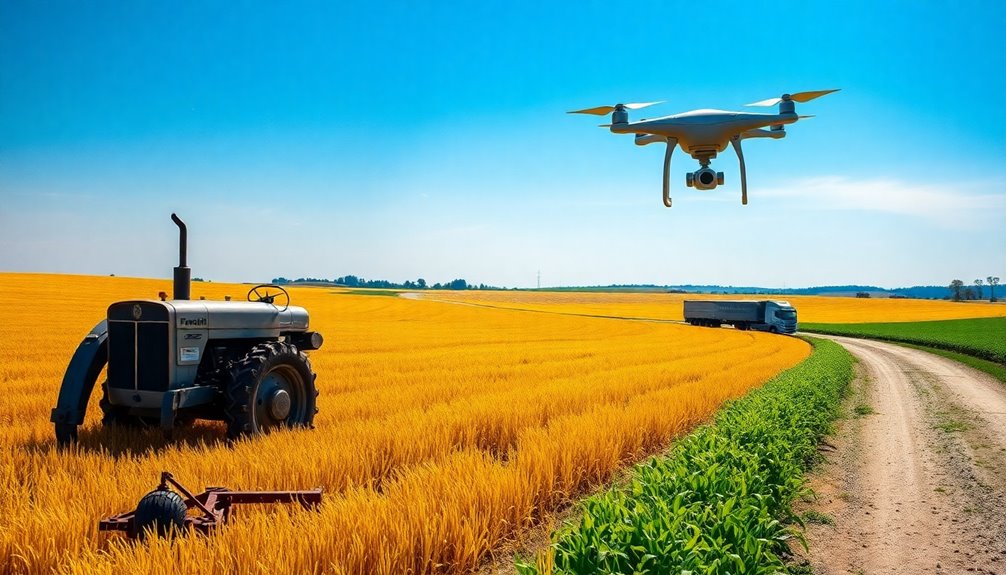
Often, technological innovations have transformed how you approach agriculture, making it more efficient and productive. These advancements have led to significant changes in farming practices, enhancing crop yield and sustainability.
Here are three key innovations:
- Mechanized farming tools like tractors and seed drills have reduced labor needs while allowing you to cover larger areas quickly.
- Irrigation systems such as drip and sprinkler technologies maximize water usage, especially in arid regions, boosting overall productivity.
- Refrigerated transport enables quick movement of perishable goods, preserving quality and reducing waste, crucial for transporting fruits, vegetables, and dairy.
These innovations not only improve your farming practices but also guarantee that you can meet market demands efficiently, thanks to improved transportation and resource management. Furthermore, the rise of blockchain technology has the potential to enhance supply chain transparency in agriculture.
Social and Cultural Changes
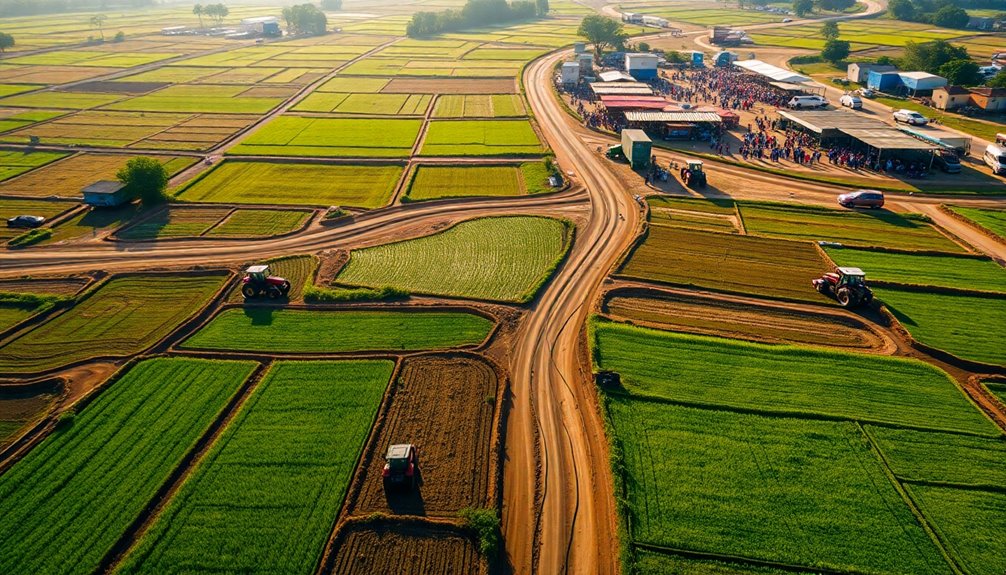
With improved transportation networks reshaping landscapes, social and cultural changes have emerged that greatly impact rural communities.
You'll notice that migration patterns shift as people move to rural areas, drawn by accessible farming opportunities. Enhanced communication between farmers and consumers fosters a better understanding of market demands and preferences, leading to more responsive agricultural practices.
Cultural exchanges between urban areas and rural communities thrive, allowing the sharing of innovative agricultural practices. As transportation improves, cooperative farming initiatives flourish, enabling farmers to collaborate and share resources effectively.
This shift towards commercial agriculture transforms traditional farming methods, increasing the variety of agricultural products available in local markets and enriching community life.
Environmental Considerations
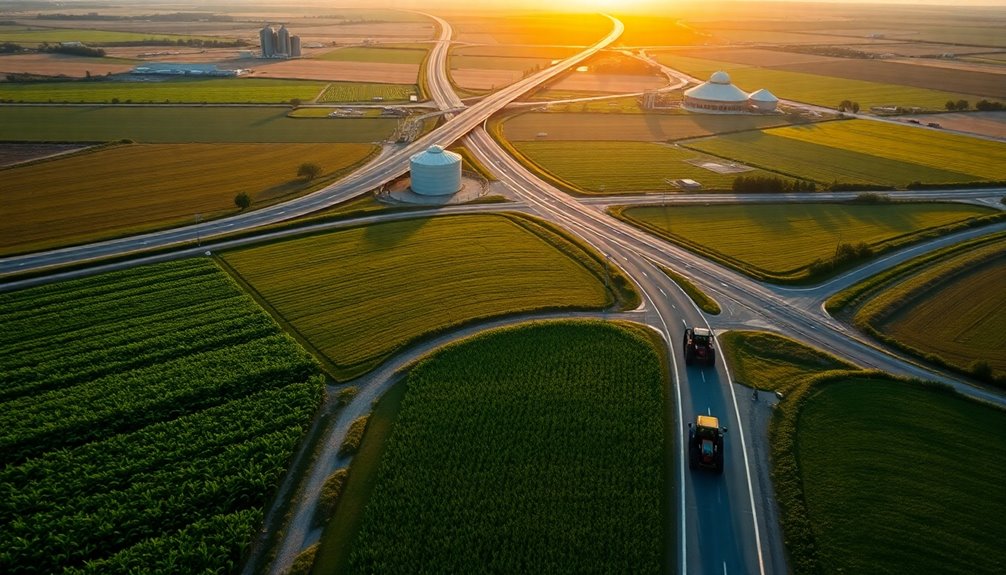
As rural communities adapt to improved transportation networks, they must also confront the environmental implications that come with these changes.
While agricultural revolutions have boosted supply and demand, they often lead to significant habitat loss and biodiversity decline.
Here are three key environmental considerations:
- Carbon Emissions: Transportation advancements increase carbon footprints, raising concerns about climate change.
- Intensified Farming: Enhanced connectivity can result in soil degradation and water resource depletion in affected areas.
- Long-Distance Transport: Relying on distant markets challenges sustainability and exacerbates the environmental impact of food systems.
To mitigate these issues, implementing sustainable transportation practices, like electric vehicles and efficient logistics, is essential. Additionally, heat pump technology can be integrated into farming operations to utilize renewable energy sources and reduce overall emissions.
Balancing improved transportation with environmental stewardship will guarantee a healthier ecosystem for future generations.
Frequently Asked Questions
How Did Improved Transportation Affect Farming?
Improved transportation revolutionized farming by making it easier for you to access wider markets.
You can now quickly move perishable goods, reducing waste and boosting profits. As costs drop, you're encouraged to specialize in high-value crops, shifting from subsistence to commercial farming.
Enhanced logistics mean you can invest in mechanized tools that increase efficiency, allowing you to produce more with less effort.
This transformation greatly elevates agricultural productivity and economic opportunities for you as a farmer.
How Were Farmers Impacted by the Transportation Revolution?
The transportation revolution was like throwing a lifeline to farmers, transforming their lives overnight!
You saw your produce fly off to distant markets, boosting your profits and expanding your horizons. With faster access to specialized machinery, your efficiency skyrocketed, allowing you to grow high-value crops.
However, you also faced new challenges; the market's whims could swing your income like a pendulum.
Still, the opportunities to thrive outweighed the risks, didn't they?
How Did Improved Transportation Affect the Industrial Revolution?
Improved transportation during the Industrial Revolution transformed economies and societies.
You saw faster movement of goods, which cut costs and opened new markets. This efficiency led to increased production and innovation, as businesses could supply more customers swiftly.
With railroads and steamships, you experienced urbanization firsthand, as populations flocked to cities for jobs, reshaping lifestyles and communities.
Connectivity became essential, driving the demand for new products and services, and fueling economic growth across the board.
How Did Improved Transportation Affect Farming Quizlet?
Improved transportation revolutionized farming by making it easier for you to reach distant markets.
With better roads, railroads, and waterways, you could move your produce faster and at lower costs. This reduced waste from perishable goods and increased your profits.
Access to new markets shifted many farmers from subsistence to commercial practices.
Plus, modern transport allowed you to adopt mechanized tools, boosting productivity and reducing your reliance on manual labor.
Conclusion
In the end, it's ironic how improved transportation, meant to connect farmers with markets, sometimes left them more isolated in their practices. While you might've thought better roads and railways would lead to a harmonious farming future, they often led to a focus on monocultures and large-scale operations. So, while you're enjoying fresh produce from across the country, remember that the very advancements designed to help farmers also changed the landscape of agriculture in unexpected ways.

